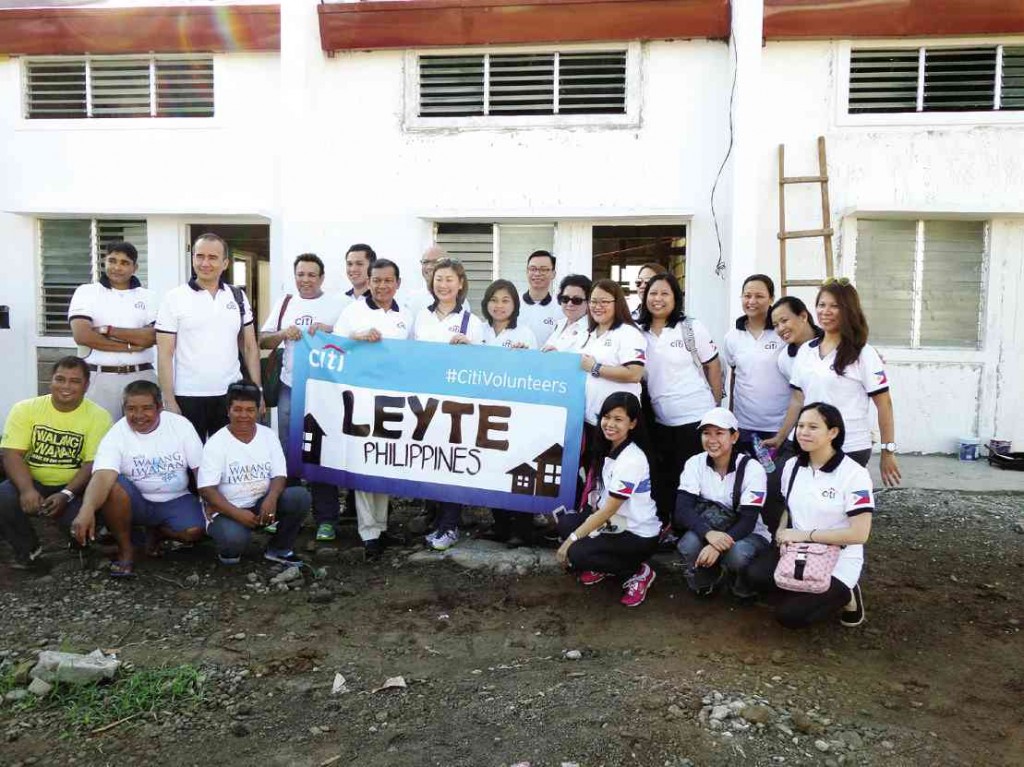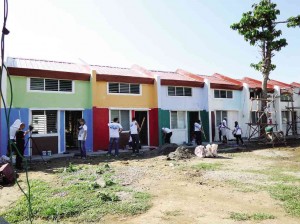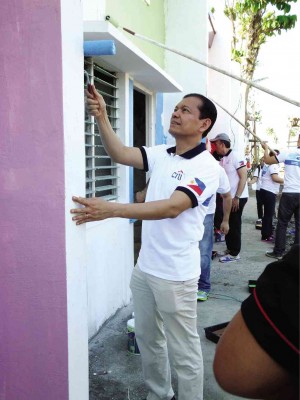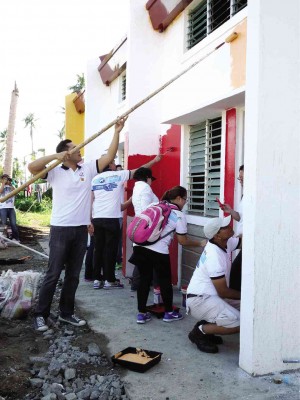Relief aid beyond the financial
On June 7, more than a dozen Citibank officers and employees, headed by Philippine chief executive officer Batara Sianturi, spent a whole morning painting the newest building at the Gawad Kalinga housing project in Barangay Pago, Tanauan, Leyte for families displaced by Supertyphoon “Yolanda.”
Painting the set of modest row houses orange, blue, red and green, the half-day work provided one bright spot in the otherwise bleak landscape the supertyphoon left behind in Tanauan, less than an hour away from the capital city of Tacloban.
The “paint job” was one of several activities undertaken by Citi volunteers as part of the annual Global Community Day (GCD) marked on June 7 by the multinational corporation in 93 countries where it does business.
“Volunteer service is one of the many ways Citi shows its commitment to the communities where we have a presence,” says Citi CEO Michael Corbat. “Global Community Day highlights the great work of our community and nonprofit partners …”
Although technically just a one-day event, Citi volunteer work in the Philippines was done across four Saturdays. “For the Philippines, Global Community Day is a misnomer,” says Sianturi, “because we celebrate this milestone across several weekends to give our 7,000 employees many opportunities to serve again and again.”
At least 1,000 Citi Philippine volunteers participated from May 17 to June 14 in 17 GCD activities that included farming and tree-planting, supporting sustainable social enterprise and engaging community children in a morning of arts and crafts.
Nearly 900 volunteers walked alongside persons with disabilities to raise awareness of their rights and plight. Citi employees handed out slippers to street children, conducted a clean-up drive in Anilao, Batangas and gave talks on money matters to microentrepreneurs and marginalized women.
The activities were held in partnership with nonprofit institutions like Bayan Academy, Childhope Philippines, Gawad Kalinga, Hands On Manila and Philippine Business for Social Progress.
For GCD itself, Sianturi led the painting of the new homes for Yolanda survivors. The GK housing project is built on elevated land far from Tanauan’s coastline to minimize risk from storm surges like those brought by Yolanda. GK coordinator Celso Bacalla says the design came from the National Housing Authority.
When completed, the project will accommodate about 380 families identified by the local government as qualified for relocation, Bacalla says. He adds the enrollment process assessed the applicants’ willingness to work and help build their own homes.
As in other GK projects, prospective beneficiaries have to complete a minimum number of hours of work to qualify. Husband and wife Arnelo and Felisa Abas, who monitor how much time applicants spend at the site, decided to give priority to providing their family a safe and comfortable home, even if it meant he could not resume full-time his old livelihood of selling fish.
Arnelo knew first-hand what living in the danger zone was like. With his family safe on higher ground when Yolanda hit, he kept watch over their house, thinking, like most people in the Philippines’ typhoon belt, that it was just another tropical storm.
Storm surges swept him away and he floated for what seemed like eternity and gave up hope of survival.
Bienvenido de Paz, president of the homeowners’ association, also cannot work full-time yet and has to rely on financial support from his children in Manila.
Citi partly funded the project from over $1 million it raised last year for disaster relief with the help of Citi Foundation, Citi employees and clients. Sianturi says, “It was great to see that our funds not only came to their [Yolanda victims’] aid when they needed it the most, but even now, provide some families hope to move away from tents into homes they can call their own.”
Although Sianturi talks only about the financial assistance, the Citi team’s visit to the GK project demonstrates that, for many businesses, relief aid has gone beyond monetary.
Businesses are increasingly supplementing the impersonal financial hand-out with hands-on engagement by their officers and employees, who donate time, effort and even their own resources to advance their corporate social responsibility goals.
As GK’s Jose Luis Oquinena put it during the first roundtable session on corporate volunteerism Citi organized to launch formally the 9th GCD, “Volunteerism is the new currency for development.” It depoliticizes and decommercializes the process of development. People working together, he says, is an economic force.
Oquinena says the Filipino bayanihan tradition is all about solidarity with the people, everyone moving in one direction or, as in the GK motto, “Walang Iwanan” (nobody gets left behind). By taking into account physical contributions, even the poor can help advance development goals.
Oquinena says volunteerism has become a “sexy and fashionable” form of heroism.
Teresita Silva of Childhope Philippines says, “Hands-on work could not substitute for financial/material gifts.”
Gianna Montinola of Hands On Manila stresses the importance of mobilizing people to contribute talent and resources in bringing citizens together to achieve certain goals.
Vicky Co of the Philippine Business for Social Progress and Bayan Academy’s Raul Manikan also underscore the importance of volunteerism under current circumstances.
Sianturi expresses confidence that for Citi people the spirit of service will not start and end with GCD.
“The spirit of bayanihan is evident year round and I saw this personally during Supertyphoon Yolanda. Their (Citi officers and employees) actions make me very proud to be working for an institution like Citi, alongside people who live and breathe the importance of making a positive impact in their community,” he says.





